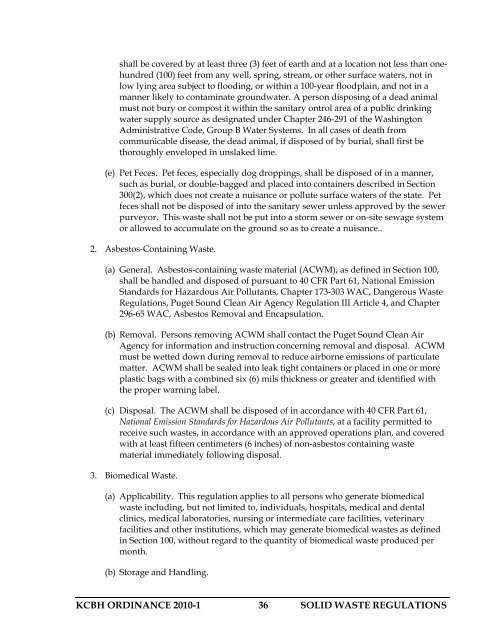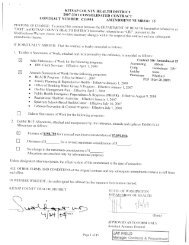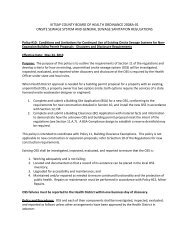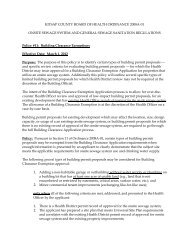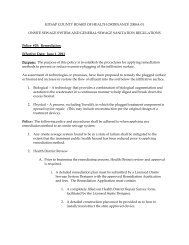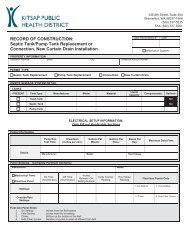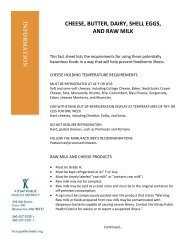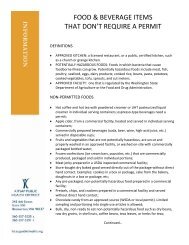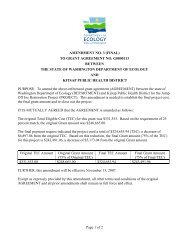SOLID WASTE REGULATIONS - Kitsap Public Health District
SOLID WASTE REGULATIONS - Kitsap Public Health District
SOLID WASTE REGULATIONS - Kitsap Public Health District
You also want an ePaper? Increase the reach of your titles
YUMPU automatically turns print PDFs into web optimized ePapers that Google loves.
shall be covered by at least three (3) feet of earth and at a location not less than onehundred<br />
(100) feet from any well, spring, stream, or other surface waters, not in<br />
low lying area subject to flooding, or within a 100-year floodplain, and not in a<br />
manner likely to contaminate groundwater. A person disposing of a dead animal<br />
must not bury or compost it within the sanitary ontrol area of a public drinking<br />
water supply source as designated under Chapter 246-291 of the Washington<br />
Administrative Code, Group B Water Systems. In all cases of death from<br />
communicable disease, the dead animal, if disposed of by burial, shall first be<br />
thoroughly enveloped in unslaked lime.<br />
(e) Pet Feces. Pet feces, especially dog droppings, shall be disposed of in a manner,<br />
such as burial, or double-bagged and placed into containers described in Section<br />
300(2), which does not create a nuisance or pollute surface waters of the state. Pet<br />
feces shall not be disposed of into the sanitary sewer unless approved by the sewer<br />
purveyor. This waste shall not be put into a storm sewer or on-site sewage system<br />
or allowed to accumulate on the ground so as to create a nuisance..<br />
2. Asbestos-Containing Waste.<br />
(a) General. Asbestos-containing waste material (ACWM), as defined in Section 100,<br />
shall be handled and disposed of pursuant to 40 CFR Part 61, National Emission<br />
Standards for Hazardous Air Pollutants, Chapter 173-303 WAC, Dangerous Waste<br />
Regulations, Puget Sound Clean Air Agency Regulation III Article 4, and Chapter<br />
296-65 WAC, Asbestos Removal and Encapsulation.<br />
(b) Removal. Persons removing ACWM shall contact the Puget Sound Clean Air<br />
Agency for information and instruction concerning removal and disposal. ACWM<br />
must be wetted down during removal to reduce airborne emissions of particulate<br />
matter. ACWM shall be sealed into leak tight containers or placed in one or more<br />
plastic bags with a combined six (6) mils thickness or greater and identified with<br />
the proper warning label.<br />
(c) Disposal. The ACWM shall be disposed of in accordance with 40 CFR Part 61,<br />
National Emission Standards for Hazardous Air Pollutants, at a facility permitted to<br />
receive such wastes, in accordance with an approved operations plan, and covered<br />
with at least fifteen centimeters (6 inches) of non-asbestos containing waste<br />
material immediately following disposal.<br />
3. Biomedical Waste.<br />
(a) Applicability. This regulation applies to all persons who generate biomedical<br />
waste including, but not limited to, individuals, hospitals, medical and dental<br />
clinics, medical laboratories, nursing or intermediate care facilities, veterinary<br />
facilities and other institutions, which may generate biomedical wastes as defined<br />
in Section 100, without regard to the quantity of biomedical waste produced per<br />
month.<br />
(b) Storage and Handling.<br />
KCBH ORDINANCE 2010-1 36 <strong>SOLID</strong> <strong>WASTE</strong> <strong>REGULATIONS</strong>


